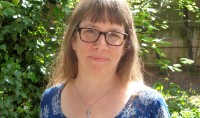
I have always loved the dark seasons. The darkness of the womb in Advent, the deep darkness of the heart in Lent. I love the way the unknown presses on all that we know as we feel our way along—groping, as Paul said to the people of Athens, for God. When asked to wait like an expectant mother, or to steer toward deeper water and let down my nets, I feel like I know what to do, or at least how to get started.
By contrast, Easter often feels to me like staring into the sun. The whole season of Easter is a storm of signs and wonders so brightly lit that it can leave us dazed and blinking. So much light is its own kind of darkness: “light inaccessible,” as Walter C. Smith’s great hymn says. Even Jesus’ closest followers can’t see clearly in the light of Easter. Mary Magdalene doesn’t recognize Jesus until she hears him speak her name; the disciples who meet him on the road to Emmaus don’t recognize him until he feeds them. For Thomas, it’s the touch of Jesus’ wounded body that finally brings him into view.
Read our latest issue or browse back issues.
For me, the image that best captures Easter’s glare is the scene that brings the Easter season to a close on the feast of the Ascension: Jesus’ followers huddled together on the Mount of Olives, staring into the sky.
It makes my eyes ache to think of it, and my heart, too. They have only begun to recognize the risen Jesus when he drifts out of sight. Staring into the empty sky with the sun in their eyes, would it feel as if he has never really been there at all? Do they feel overwhelmed by the sky’s immensity, wondering where in that vast blue dome they will ever find him again?
We know what is being asked of us in Advent and in Lent: to feel our way along, wait with Mary for the baby, follow Jesus into the desert, resist the devil’s easy consolations. None of this is easy, but all of it is comprehensible. The work of Advent and Lent is grounded in human experience. It is within our capacity to do.
The glory of Easter, on the other hand, erupts in a much less familiar way. The empty tomb, the living body still bearing the wounds that destroyed it, the man his friends watched die now eating breakfast with them on the beach—nothing in our experience prepares us for this. In the first line of her great poem “Catholic,” Fanny Howe asks, “What can you do after Easter?” What do we do when the preparation is over? We’ve been waiting for Easter, and here it is. What can we see with the light in our eyes?
Hildegard of Bingen, the 12th-century visionary, knew something about how to find a way forward in dazzling, even painful brightness. She lived her entire life with what she called “the reflection of the living Light” in her field of vision. She couldn’t see the form of it, she said, any more than she could stare into the sun. But rather than look straight at it, she learned how to look within it as if into a pool of water—and to watch as words and images took shape there. Every once in a while, she said, she saw a light within the light: the living Light itself, which made her feel, even when she was old, like a young girl.
Charles Singer, and later Oliver Sacks, famously diagnosed Hildegard with migraine, crediting the light she saw to a migraine’s aura. And perhaps they were right. She wrote not only of the way the living Light refreshed her but also of experiencing pain so fierce that she thought she would die. But whatever caused Hildegard’s vision to fill with a permanent radiance, she drew from that pool of light words, music, and images that became themselves pools of meaning into which she lowered herself again and again.
Maybe Hildegard has some wisdom for those of us who are struggling with the brightness of Easter. Rather than trying to stare straight at it, maybe we should be trying to look within it. Hildegard believed everything she saw within the brilliant light of her vision was meaningful. And so she wrote about what she saw, composed music about what she saw, shaped her community in response to what she saw. For Hildegard, the radiance of the living Light was deeply generative, engaging capacities she didn’t know she had. The glory of God erupted within her and led her far beyond what the world imagined a woman in pain could create.
When we look into the dazzling light of Easter, what do we see? We see the things we’ve always seen: the faces of strangers and family and friends, the communities within which we move, the world around us and beyond us, all washed in Easter’s incomprehensible light. Maybe this is one of the lessons of the visionary: that while the light does not illuminate every mystery, it does lay bare the sacredness of the world. Maybe this is why the disciples who have watched Jesus ascend eventually turn their faces from the sky to the city. With the sun still in their eyes, they are drawn beyond their fear back into the life of the world. Maybe Easter can make visionaries of us all.
A version of this article appears in the print edition under the title “The glory and the glare.”






